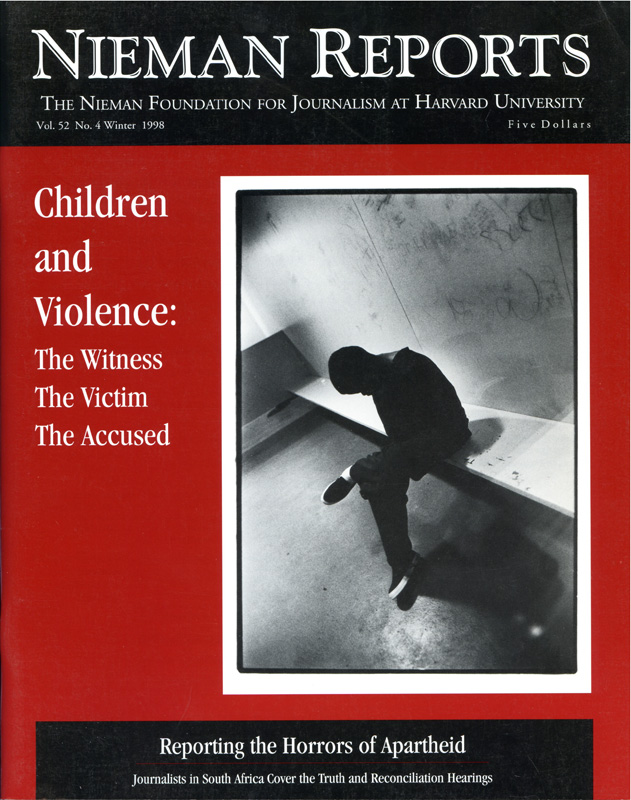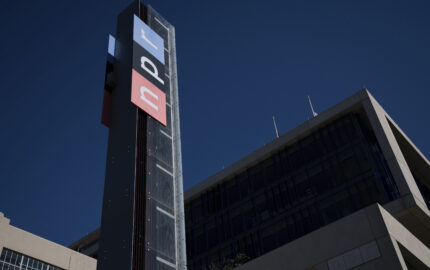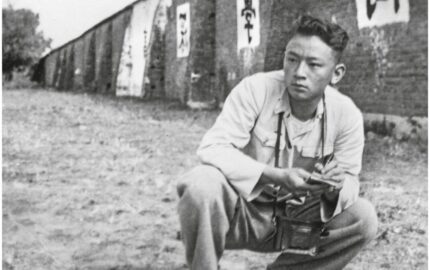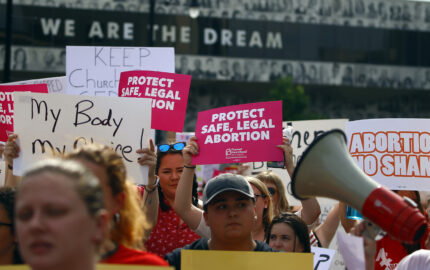
Children and Violence
In this edition, we examine ways in which we report on children and violence. We travel to the sites of the five recent and highly publicized school shootings, then journey into the private realm of family violence, as seen through the eyes of children who witness it. From there, we move into courtrooms and juvenile detention centers, and also get a glimpse of adolescent girls’ increasing involvement with crime. Then, we take a look at how customary methods of coverage shape public perception and policymaking in the arena of child and juvenile crime. Finally, editors at Chicago’s two newspapers take us inside their decision-making when it comes to coverage of children and violence.
Those looking for a balanced, critical appraisal of press performance in the Monica Lewinsky and related affairs need not read this book.
God knows, Howard Kurtz tries in “Spin Cycle: How the White House and the Media Manipulate the News.” In an updated edition to include late developments of this year, he faithfully reports the sins, as he sees them, on both sides. Part of the problem is that he starts with a built-in conflict of interest: He works as media reporter for The Washington Post, which has followed the common practice of seldom identifying sources and keeping the story prominently on the front page even when there is no significant new development. This is an old device in investigative journalism to keep the story alive when significant new facts are not available.
As a reporter of various developments in the news media Kurtz is first rate. But as a member of the Washington press corps, he is surrounded by so many Clinton haters it is a wonder he can sort out the facts as well as he does. One cannot expect to get a proper account from the center of a dogfight. What is needed is an impartial observer from the outside to bring the facts into focus and tell what they mean, such as the critics which are found in the universities and impartial think tanks.
Not that Kurtz is easy on the press. “There was a time,” he writes, “when a commander-in-chief was graded on the traditional measures of his relations with Congress, his dealings with foreign leaders, his ability to keep the economy moving and the nation at peace. Now the increasingly opinionated mass media had somehow become the arbiter of political success and the distiller of conventional wisdom. A president’s words were endlessly sliced and diced by the self-appointed pundits, his every move filtered through someone else’s ideological lens.”
Kurtz, of course, blames chiefly “the White House strategy of deflection and delay” to prevent the truth from coming out. “Eventually there comes a point when even the President of the United States cannot hide behind his spokesmen. Eventually the questions of the scandal-seeking reporters have to be answered.”
This is true and Clinton has paid dearly. But take the process a step further. To the surprise of “scandal-seeking reporters,” Americans turn on their television sets day after day to see reporters trained to be neutral investigators and observers performing like hostile prosecutors and decide in large numbers to take the side of the White House, even as they condemn the President’s behavior. The leap from the press being accused over many years as being overly liberal to now seemingly being in league with right-wing extremists out to dump at any cost a President who is a Democrat is too great for many to find credible.
This, of course, is not the only cause for Clinton’s survival at this writing. But it is a troubling phenomenon that Kurtz deals with only superficially. He seems to justify the media’s prosecutorial stance as an acceptable reaction to official obfuscation, denials and delay coming from the White House. With every round reporters become more skeptical and “at some point, even a reelected president dogged by endless scandal can no longer defy the laws of political gravity,” he writes.
Kurtz makes little effort to define the enormous, historical differences between the White House and the press, almost treating them as equals: “For all the animosity, the White House spinners and their cynical chroniclers were ultimately joined at the hip in a strangely symbiotic relationship. Both thrived on the frenetic pace of life at the center of the political universe.” The White House “needed the press to peddle their message to the public, and the journalists needed an action-packed presidency on which to build their reputations and name recognition. Yet fireworks were inevitable when the two sides got in each other’s way.”
Some reporters and editors would find that an odd definition of a journalist’s need. There was a time when it was widely believed that opinions and efforts to shape the course of government and politics should be left to the columnists and editorial writers. Here, Kurtz is clearly including reporters and editors.
Presidents have always tried to manipulate the press in one way or the other. Jimmy Carter’s 1976 pledge that “I will never lie to you” notwithstanding, all Presidents have. That the Clinton White House went to extremes is no excuse for the media to give every reporter and editor a hunting license to go after suspect officials.
The line between reporting and editorializing has been eroding ever since the Watergate days of the early 1970’s. White House press conferences and briefings are used by many journalists as more of a display of hostility and confrontation than a search for the truth. It will not do simply to blame evasive, lying officials for what many now consider the deplorable state of Washington journalism.
John Herbers, Nieman Fellow 1961, covered the White House for The New York Times during the Watergate scandal, was Assistant National Editor, and was Deputy Bureau Chief in Washington. Before his retirement, Herbers also was the paper’s national correspondent based in Washington.
God knows, Howard Kurtz tries in “Spin Cycle: How the White House and the Media Manipulate the News.” In an updated edition to include late developments of this year, he faithfully reports the sins, as he sees them, on both sides. Part of the problem is that he starts with a built-in conflict of interest: He works as media reporter for The Washington Post, which has followed the common practice of seldom identifying sources and keeping the story prominently on the front page even when there is no significant new development. This is an old device in investigative journalism to keep the story alive when significant new facts are not available.
As a reporter of various developments in the news media Kurtz is first rate. But as a member of the Washington press corps, he is surrounded by so many Clinton haters it is a wonder he can sort out the facts as well as he does. One cannot expect to get a proper account from the center of a dogfight. What is needed is an impartial observer from the outside to bring the facts into focus and tell what they mean, such as the critics which are found in the universities and impartial think tanks.
Not that Kurtz is easy on the press. “There was a time,” he writes, “when a commander-in-chief was graded on the traditional measures of his relations with Congress, his dealings with foreign leaders, his ability to keep the economy moving and the nation at peace. Now the increasingly opinionated mass media had somehow become the arbiter of political success and the distiller of conventional wisdom. A president’s words were endlessly sliced and diced by the self-appointed pundits, his every move filtered through someone else’s ideological lens.”
Kurtz, of course, blames chiefly “the White House strategy of deflection and delay” to prevent the truth from coming out. “Eventually there comes a point when even the President of the United States cannot hide behind his spokesmen. Eventually the questions of the scandal-seeking reporters have to be answered.”
This is true and Clinton has paid dearly. But take the process a step further. To the surprise of “scandal-seeking reporters,” Americans turn on their television sets day after day to see reporters trained to be neutral investigators and observers performing like hostile prosecutors and decide in large numbers to take the side of the White House, even as they condemn the President’s behavior. The leap from the press being accused over many years as being overly liberal to now seemingly being in league with right-wing extremists out to dump at any cost a President who is a Democrat is too great for many to find credible.
This, of course, is not the only cause for Clinton’s survival at this writing. But it is a troubling phenomenon that Kurtz deals with only superficially. He seems to justify the media’s prosecutorial stance as an acceptable reaction to official obfuscation, denials and delay coming from the White House. With every round reporters become more skeptical and “at some point, even a reelected president dogged by endless scandal can no longer defy the laws of political gravity,” he writes.
Kurtz makes little effort to define the enormous, historical differences between the White House and the press, almost treating them as equals: “For all the animosity, the White House spinners and their cynical chroniclers were ultimately joined at the hip in a strangely symbiotic relationship. Both thrived on the frenetic pace of life at the center of the political universe.” The White House “needed the press to peddle their message to the public, and the journalists needed an action-packed presidency on which to build their reputations and name recognition. Yet fireworks were inevitable when the two sides got in each other’s way.”
Some reporters and editors would find that an odd definition of a journalist’s need. There was a time when it was widely believed that opinions and efforts to shape the course of government and politics should be left to the columnists and editorial writers. Here, Kurtz is clearly including reporters and editors.
Presidents have always tried to manipulate the press in one way or the other. Jimmy Carter’s 1976 pledge that “I will never lie to you” notwithstanding, all Presidents have. That the Clinton White House went to extremes is no excuse for the media to give every reporter and editor a hunting license to go after suspect officials.
The line between reporting and editorializing has been eroding ever since the Watergate days of the early 1970’s. White House press conferences and briefings are used by many journalists as more of a display of hostility and confrontation than a search for the truth. It will not do simply to blame evasive, lying officials for what many now consider the deplorable state of Washington journalism.
John Herbers, Nieman Fellow 1961, covered the White House for The New York Times during the Watergate scandal, was Assistant National Editor, and was Deputy Bureau Chief in Washington. Before his retirement, Herbers also was the paper’s national correspondent based in Washington.



